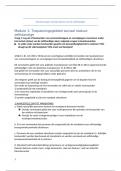Exam (elaborations)
BUS 201 FINAL EXAM QUESTIONS AND ANSWERS WITH COMPLETE SOLUTIONS
- Module
- Institution
Describe what stressors are as well as the outcomes of stress. correct answer: events or contexts that cause a stress reaction by elevating levels of adrenaline and forcing a physical or mental response Physiological: nervousness, headaches, anger Psychological: Depression and anxiety Wor...
[Show more]












